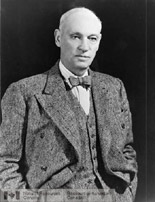|
NRCan Home > About Us > Trailblazers > Charles Camsell

Trailblazer
Charles Camsell, 1876–1958
A True "Son of the North"
Lofty visions
 Charles
Camsell was a visionary geologist and map-maker, dedicated to the exploration
of Canada's North. He believed the future of the North depended upon its
mineral wealth, and throughout his life actively promoted the country's
natural resources at home and abroad. Charles
Camsell was a visionary geologist and map-maker, dedicated to the exploration
of Canada's North. He believed the future of the North depended upon its
mineral wealth, and throughout his life actively promoted the country's
natural resources at home and abroad.
During his public service with the Geological
Survey of Canada (GSC) and the Department of Mines and Resources
(now Natural Resources Canada), Charles is best remembered for guiding
the department through the difficult war and depression years, and for
using airplanes to advance the exploration of the North.
Rock-solid beginnings
The son of a Hudson Bay Company factor, Charles was born in Fort Liard,
Northwest Territories, in 1876 and spent his formative years in the North.
Education took him south, but he returned home in 1894 with a Bachelor
of Arts in Natural Science from the University of Manitoba.
In September 1897, Charles and his brother Fred caught gold rush fever
and set out to stake a claim in the Yukon. They abandoned their idea en
route to the Klondike after suffering months of formidable weather conditions,
indomitable terrain and near-starvation. Although they found no gold in
the hills, Charles discovered an interest in geology and exploration.
Over the next few years, he studied geology and mineralogy at Queen's
University, did mineral exploration for several companies and took graduate
degree courses at two other universities.
The GSC years — from north to south
Several years later in Fort Providence, Northwest Territories, Charles
met James Mackintosh Bell, who was exploring Great Bear Lake for the GSC.
Since Charles had extensive experience travelling in the North, Bell hired
him as an assistant — an introduction to a long and productive
association with the GSC.
In the spring of 1902, the GSC
asked Charles to take a survey of salt deposits and the wood buffalo in
the area between Peace River and Slave River. He discovered that the animals
had dwindled to one herd of 300. His findings prompted the federal government
to transfer nearly 7,000 plains buffalo to the region. Within 30 years,
the population had increased to 20,000 animals, preserving buffalo herds
in the North.
In June 1904, Charles received a letter from the head of the GSC,
appointing him to a job he had not even applied for. He spent the early
part of his career on various geological expeditions that took him to
some of the most remote locations in the North. He also did geological
fieldwork in southern British Columbia, taking a detailed survey of the
unique gold deposits of Nickel Plate Mountain.
In January 1914, Charles was appointed GSC's
Geologist in Charge of Exploration — a daunting task. His job
was to oversee exploration of the unknown parts of Canada's North —
a vast area covering 1.4 million square kilometres or about 25 percent
of the country. By the end of the decade, Charles began encouraging survey
exploration teams to use airplanes. Using aerial photography, the teams
completed the geological survey of northern Canada by 1950.
Charles opened up a GSC
branch office in Vancouver in 1918 to oversee work in British Columbia
and the Yukon.
Active public service
In 1920, Prime Minister Arthur Meighen appointed him Deputy Minister
of Mines.
In this new role, Charles promoted Canada's natural resources at scientific
conferences around the world. In Ottawa, he was active on many committees
and boards, and was a member of the National Research Council for 15 years.
He authored numerous geological papers and implemented laboratory research
to complement field exploration.
In 1936, Mackenzie King's government merged several federal departments —
Mines, Interior, Immigration and Indian Affairs — and renamed
the new organization the Department of Mines and Resources. Charles was
retained as deputy minister and was also appointed Commissioner of the
Northwest Territories and Indian Affairs.
In 1946, at age 70, Charles retired from public service, but he remained
dedicated to his work, which he continued to write about until his death
in 1958.
Honoured geographer and geologist
In 1929, Charles founded the Royal Canadian Geographical Society. He
was president of the society for 11 years and an avid supporter of the
organization's Canadian Geographical Journal (now Canadian
Geographic and Géographica).
Charles was recognized for his dedication to Canada's mining and natural
resources with honourary law degrees, as well as numerous medals and distinctions,
including Fellow of the Royal Geographical Society. The Camsell River
in the Northwest Territories is named in his honour.
Lifetime achievements
- 1894 Graduated from the University of Manitoba
- 1904 Joined the Geological Survey of Canada
- 1914 Appointed Geologist in Charge of Exploration
- 1918 Opened Geological Survey of Canada office in Vancouver
- 1920 Appointed Deputy Minister for the Department of Mines
- 1929 Founded the Canadian Geographical Society
- 1935 Made Companion of Order of St. Michael and St. George by King
George V
- 1936 Appointed Deputy Minister of the Department of Mines and Resources
and Commissioner of the Northwest Territories
- 1946 Governor General Lord Alexander opened The Charles Camsell tuberculosis
hospital in Edmonton
Retired from public service
- 1954 Published his autobiography, Son of the North
More Trailblazers
|


